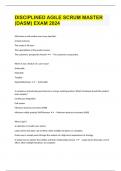College aantekeningen
Notes Advanced Molecular Gastronomy FPH-31306
Notes Advanced Molecular Gastronomy (FPH31306). The notes are quite extensive but contain all information necessary to pass the course. They also contain parts of the lecture slides for better understanding of the course material.
[Meer zien]













